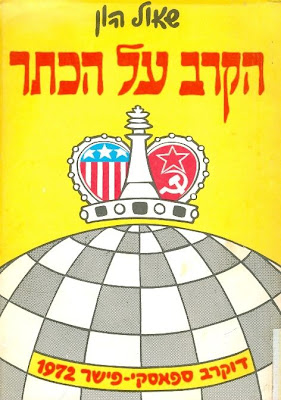
The Israel chess world has lost one of its oldest and most active members --
Shaul Hon. As the obituary in the Israeli Chess Association's bulletin (Aug. 2009, p. 38) notes, he was a true polymath -- earning a degrees from the Hebrew University in nine (!) different fields, including
inter alia biblical studies, art history, linguistics, and law. The obituary adds that he was
Ma'ariv's (Israel's largest, or second-largest, newspaper) resident reporter for chess, law, and archeology -- surely a unique combination.
Hon's
author's page on an Israeli used-book internet 'clearing house' lists fifteen different books (not counting "doubles") of which eleven are chess books. This is without taking into account his hundreds of articles, columns, investigative reports, etc. on various subjects, from literature and law to art history and chess.
Hon was the only (so far as I know) Israeli reporter that covered live the 1972
Fischer -
Spassky world championship match. As he related in his book,
Ha'Krav al ha'Keter [The Fight for the Crown] (Tel Aviv: Ma'ariv Library Press, 1972), he was the first reporter in the world to officially break the story that Fischer is going to forfeit the second game on time -- half an hour before all other reporters. As Hon explains, after Fischer was 30 minutes late, he realized Fischer might like to be late 5 or 10 minutes, but certainly not half an hour, and that therefore he will not show up.
Hon was a bit of a fanatic for correct Hebrew -- unsurprising, considering he was
inter alia a student of
Naftali Hertz Tur-Sinai (
nee Turtschiner), the head from the 1930s to 50s of the Academy of the Hebrew language, an institute whose
raison d'etre is to find Hebrew words to replace foreign ones. (Tur-Sinai, by the way, was satirized by the humorist
Efraim Kishon in the 1950s in the character of 'Elihav bar-Ahisemech, the living soul of the Hebrew language'.)
Tur-Sinai, Hon related in a 1964 article, sent him to 'purify our chess terms from foreign expressions that unfortunately still appear in our midst.' (Hon, Shaul.
Minuach Ivri be’Shachmat [Hebrew Terminology in Chess].
Shachmat, 2nd year, no. 8 (March 1964), pp. 3-4.) Hon suggests, e.g., that since a pawn in Hebrew is a
hayal (lit. 'soldier'), one should not talk of
kelim kalim and
kelim kvedim ('light pieces' and 'heavy pieces', from the English) but rather of
ktzinim zutarim and
ktzinim bechirim (junior and senior officers). The international term 'Zugzwang' should be replaced with the Hebrew
kfai ('to be forced to act', from
the verb
kefot, 'to force someone to act'.) Naturally,
kfai must not be confused with
kfat -- 'to be completely tied up' -- Hon's translation of the German (and Hebrew chess jargon)
Patt, or stalemate.
It is not surprising these suggestions did not succeed, since players are not likely to change common terms just to preserve perfect logical consistency in their jargon. However, some suggestions were accepted: for example, to replace
gilgul (lit. 'reincarnation') with
hachtara (lit. 'coronation') as the Hebrew term for 'promotion'. Most players seem to intuitively think of the promoted pawn itself (or, as in
Through the Looking Glass, herself) as rising in rank, usually to royalty, not as "dying" and being "reincarnated" as a piece -- despite the fact that the pawn is in fact removed form the board and another piece (usually the queen) put in its place.
May he rest in peace.
(Photo above: cover of Ha'Krav al ha'Keter, Hon's 1972 book about the Fischer-Spassky match.)

